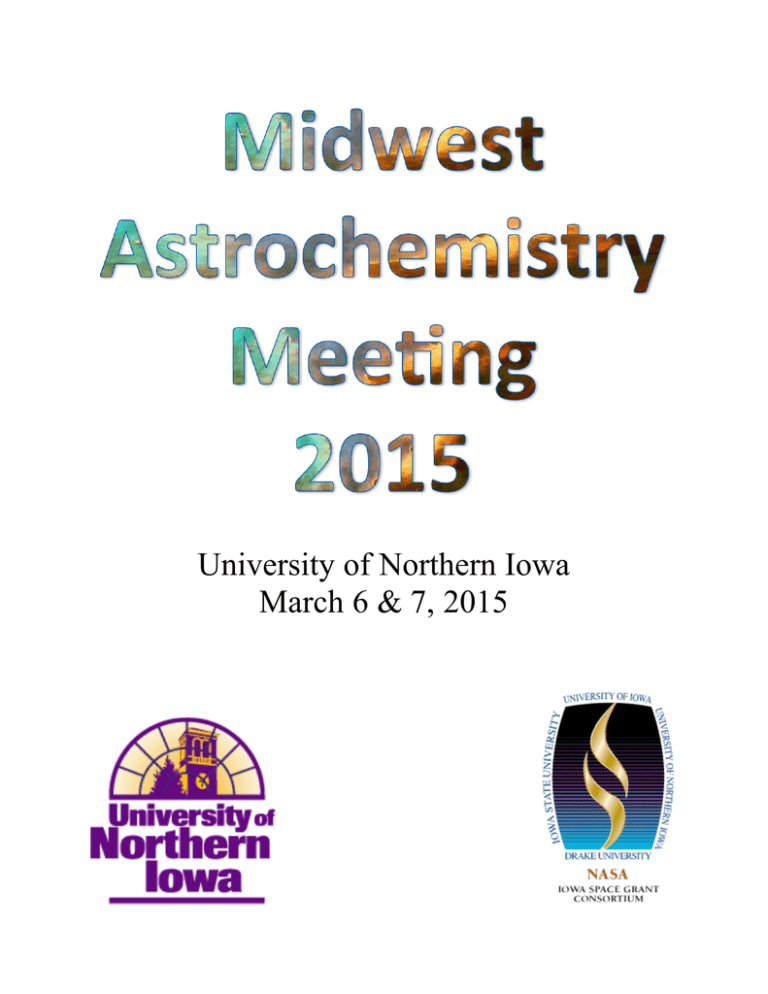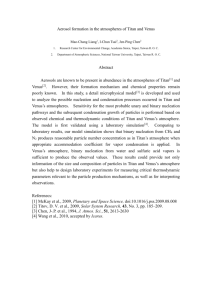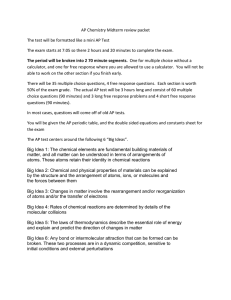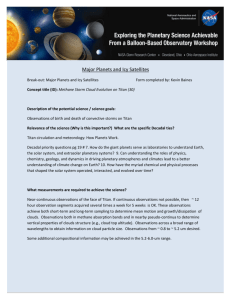University of Northern Iowa March 6 & 7, 2015
advertisement

University of Northern Iowa March 6 & 7, 2015 Midwest Astrochemistry Meeting 2015 Schedule of Events Friday, 6 March 2015 4:30-5:30 PM Dr. Ricardo Arevalo, Jr., Research Space Scientist at NASA Goddard Space Flight Center, will present “IT’S A TRAP! A REVIEW OF THE MOMA INSTRUMENT ABOARD EXOMARS 2018, AND OTHER ION TRAPS IN SPACE OR UNDER DEVELOPMENT”. He will speak in Room 201, McCollum Science Hall. Refreshments will be available at 3:30 PM. 6:00-9:00 PM The poster session will be held in the lounge outside MSH201. Posters may be hung after 5:00 PM. Pizza and beverages will be available starting around 6:30 PM. Saturday, 7 March 2015 Oral sessions will be held in Room 201, McCollum Science Hall. The building entrances should be unlocked by 8:00 AM. The first session will begin at 8:45 AM. There will be a mid-morning break with coffee and snacks, and lunch will be provided in the form of box lunches. The meeting is scheduled to adjourn around 1:30 PM. Parking The Chemistry and Biochemistry Department is located on the top floor of McCollum Science Hall (#43 on the campus map). If needed, there is a dock available at the east end of McCollum Science Hall for unloading. Free parking is available in the “A” lot after 4 PM as noted on the map. It is a short walk to McCollum Science Hall from the parking lot. See campus map on next page. There will be time between the seminar at 4 PM and the poster session for people who arrive early to go check in at their hotels. See maps for building and parking lot locations. Friday Keynote Talk IT’S A TRAP! A REVIEW OF THE MOMA INSTRUMENT ABOARD EXOMARS 2018, AND OTHER ION TRAPS IN SPACE OR UNDER DEVELOPMENT Dr. Ricardo Arevalo, Jr. NASA Goddard Space Flight Center Recently, ion trap mass spectrometers have found a niche as small, versatile alternatives to traditional quadrupole mass analyzers, capable of in situ characterization of planetary environments and the search for organic matter. The Rosetta space probe, which was built and launched by ESA in March 2004 and became the first spacecraft to orbit a comet in August 2014, successfully landed the Philae robotic lander carrying the first planetary ion trap on comet 67P/C-G in November 2014. The 2018 mission of the ESA ExoMars Program will deliver a European rover equipped with the next ion trap dedicated to planetary exploration: the Mars Organic Molecule Analyzer (MOMA). The MOMA instrument represents an international collaboration between NASA and ESA, and the core astrobiological experiment of the entire ExoMars Program. The heart of the MOMA instrument is a 2D (or “linear”) ion trap designed to facilitate two symmetrical ion injection pathways, thereby enabling both laser desorption mass spectrometry (LDMS) at Mars ambient pressures and traditional gas chromatography mass spectrometry (GCMS) techniques. These two complementary modes of operation empower MOMA with an unprecedented ability to detect both volatile and refractory organic molecules, in addition to providing geochemical context through the measurement of inorganic signatures of sample mineralogy. In particular, the analysis of nonvolatile higher molecular weight organics, even in the presence of perchlorate, has been demonstrated on multiple breadboard platforms and the flight-like engineering test unit (ETU). In light of the demonstrated proficiencies of these instruments, significant resources have been invested to develop a series of even more capable ion traps for future spaceflight applications; examples include the development by GSFC of an enhanced Linear Ion Trap Mass Spectrometer (LITMS) with negative ion detection and core sampling compatibility; the Mass Analyzer for Real-time Investigation of Neutrals at Europa (MARINE) pioneered by JPL; and, the evolution of a high-resolution (up to m/Δm = 1E5; full width at half maximum, or FWHM) Orbitrap mass analyzer for spaceflight, as advanced by the French Orbitrap Consortium. Poster Session – 6 March 2015 P1. A Continuous Supersonic Expansion Discharge Source for HighPrecision Mid-Infrared Spectroscopy of Cold Molecular Ions Courtney N. Talicska, Mike W. Porambo, and Benjamin J. McCall P2. A Continuous Supersonic Expansion Discharge Source for HighPrecision Mid-Infrared Spectroscopy of Cold Molecular Ions High Precision Spectroscopy of Molecular Ions Relevant to the Interstellar Medium Charles R. Markus, Adam Perry, James Hodges, G. Stephen Kocheril, and Benjamin McCall P3. Analysis of Rotationally Resolved C3 using Updated Oscillator Strengths Nicole C. Koeppen, and Benjamin J. McCall P4. Exploring Titan’s Atmospheric Chemistry Through Laboratory Simulations Angela Weepie, Quentin Pavic, and Dr. Joshua Sebree P5. The Measuring of Cosmic Rays During a High-Altitude Balloon Flight Michael Madsen, Bawa Sadjifo, Kyle Spurgeon, Elizabeth Turcotte, Angela Weepie, Alex Oberle and John Ophus P6. ADMIT: ALMA Data Mining Toolkit Douglas N. Friedel, Leslie W. Looney, Lisa Xu, Marc W. Pound, Peter J. Teuben, Kevin P. Rauc3, Lee G. Mundy, and Jeffrey S. Kern P7. Impact of Laboratory Studies of the C + H3+ Reaction on Astrochemical Models Shreyas Vissapragada, Daniel Wolf Savin Schedule for Oral Session – 7 March 2015 T1. (Open Forum, 8:45-9:15) The NASA Postdoctoral Program and other Early Career opportunities at NASA. Joshua A. Sebree (9:15-9:30) Break T2. (9:30-9:50) CARMA 1 CM Line Survey of Orion-KL Douglas N. Friedel, Leslie W. Looney, Anthony J. Remijan, and Joanna Corby T3. (9:50-10:10) Determining the Chemistry of Super-Earth Exoplanet Atmospheres Eliza Kempton T4. (10:10-10:30) Clouds in Super-Earth Atmospheres - Equilibrium Chemistry Calculations Rostom Mbarek, Eliza Kempton (10:30-10:45) Break T5. (10:45-11:05) Low temperature HD + ortho-/para-H2 inelastic scattering of astrophysical interest Renat A. Sultanov T6. (11:05-11:25) Exploring Pathways to Nitrogen Containing Heteroaromatics is Titan’s Atmosphere: Spectroscopy of Cyanostyrene Isomers Joseph A. Korn, Stephanie N. Knezz, Robert J. McMahon, and Timothy S. Zwier T7. (11:25-11:45) Spectroscopic analysis of Titan Analog Aerosols Angela Weepie, Quentin Pavic, and Joshua Sebree (11:45-1:00) Lunch/Closing Poster Abstracts A Continuous Supersonic Expansion Discharge Source for HighPrecision Mid-Infrared Spectroscopy of Cold Molecular Ions Courtney N. Talicska, Mike W. Porambo, and Benjamin J. McCall Department of Chemistry, University of Illinois at Urbana-Champaign Molecular ions play an essential role in the chemistry that has formed the universe and there is a need for high-precision laboratory spectra of ions that may be present in the interstellar medium. In order to facilitate new astronomical discoveries and provide for a deeper understanding of the chemical theory of molecular ions, it is necessary to improve the precision to which spectra of such ions can be measured. However, forming ions in measurable quantities in the laboratory has proved challenging due to low ion-to-neutral ratios. Typical discharge cells, even when cryogenically cooled, are subject to high temperatures and pressures that result in diluted and congested spectra which makes extracting chemical information difficult. Here, we overcome this challenge by coupling an electric discharge to a continuous supersonic expansion to form ions cooled to low temperatures (~30 K for ions that cool efficiently). Cooling of ions formed by the discharge is achieved as high pressure gas leaving the source expands adiabatically into a vacuum, creating an environment ideal for the longer-lived existence of cooled ions. Noise-immune cavity-enhanced optical heterodyne molecular spectroscopy (NICE-OHMS) is used to probe the expansion with mid-infrared radiation (3-5 µm) formed through difference frequency generation. To further improve the sensitivity of the NICE-OHMS technique, the discharge is electrically modulated at 1 kHz and demodulated by a lock-in amplifier before being recorded by a custom data acquisition program. Transitions of H3+ and HN2+ have been recorded with excellent signal-to-noise and rotational temperatures of 80120 K and 35-45 K, respectively. With verification that the source is producing rotationally cold ions we plan to move on to study primary ions of astronomical significance, including H2CO+. Presenting Author’s E-mail: talicsk2@illinois.edu High Precision Spectroscopy of Molecular Ions Relevant to the Interstellar Medium Charles R. Markus1,3, Adam Perry1, James Hodges1, G. Stephen Kocheril1, and Benjamin McCall1,2 cmarkus2@illinois.edu 1 Dept. of Chemistry, Univ. of Illinois at Urbana-Champaign, Urbana, IL 61801 Dept. of Astronomy, Univ. of Illinois at Urbana-Champaign, Urbana, IL 61801 3 cmarkus2@illinois.edu 2 In the vast cold regions between the stars, chemistry manages to thrive through interactions between molecular ions and neutral species. These reactions are able to occur despite the low number densities and temperatures of the interstellar medium (ISM) due to their low activation barriers. Therefore molecular ions dominate the chemistry and dynamics of the ISM. Their observation allows for valuable insight into the physical characteristics of these regions. Identifying molecular ions in the ISM is often complicated by congested spectra requiring high precision laboratory data to make an assignment with confidence. Recording laboratory spectra of molecular ions poses many challenges. They are often produced in low number densities in laboratory discharges and their signals are dwarfed by neutral species. To overcome this techniques which increase signal strength, reduce instrumental noise, and discriminate between ions and neutrals are utilized. Our technique, described as noise immune cavity enhanced molecular heterodyne velocity modulation spectroscopy (NICE-OHVMS), is able to accomplish this. By putting our ion source within an optical cavity the effective path length is increased by a factor of 100 allowing for weak absorption signals to be observed. Velocity modulation spectroscopy is used to discriminate between ions and neutrals. To further improve our sensitivity heterodyne methods are used. An electro-optic modulator phase modulates the light to produce sidebands, and detection occurs at radio frequencies which reduces technical noise. The combination of these techniques allows for a wide variety of molecular ions to be observed in the mid-IR. To gain high precision, we use a GPS referenced frequency comb to calibrate our laser granting sub MHz precision of line centers. This technique has been used to investigate HCO+, HeH+, H3+, CH5+, and OH+ which are all of astrochemical interest. Analysis of Rotationally Resolved C3 using Updated Oscillator Strengths Nicole C. Koeppen* Department of Chemistry, University of Illinois, Urbana, IL 61801 Benjamin J. McCall Departments of Chemistry and Astronomy, University of Illinois, Urbana, IL 61801 Observations of carbon chain molecules are useful in determining the temperature profiles of diffuse interstellar clouds. In 2003, C3 was observed in ten different sightlines and the rotational column densities and the temperature distributions were determined using the oscillator strengths available at that time. The method for fitting these high signal-to-noise spectra involved separately adjusting each rotational level population in order to obtain the best fit of the P, Q, and R branches.1 This past year, new oscillator strengths for the C3 rotational states were calculated by including the effects from intensity borrowing to the nearby perturbing states.2 With these new oscillator strengths, we have used the same method of individually fitting each J level population of the previous ten C3 spectra to determine more accurate values for the rotational column densities, which are used to calculate the temperatures of the clouds. 1 2 Adamkovics et al. Ap.J., 595, 235 (2003) Schmidt et al. MNRAS, 441, 1134 (2014) *presenting author's contact: nkoeppe2@illinois.edu Spectrum of C3 observed in the sightline HD21483 from 2003, shown with the updated fit (offset above) from independently adjusting the rotational levels with the updated oscillator strengths. Exploring Titan’s Atmospheric Chemistry Through Laboratory Simulations Angela Weepie, Quentin Pavic, and Dr. Joshua Sebree Department of Chemistry and Biochemistry, University of Northern Iowa Titan, Saturn’s largest moon, is unique in that it is the only moon in our solar system with a dense atmosphere. Titan has a temperature and pressure profile that allow for an active hygrological system with gaseous, liquid, and solid phase methane and ethane taking the role that water plays on Earth.2 While Titan is much colder, its atmospheric chemistry is comparable to that of an early Earth.1 Understanding the chemical processes occurring in Titan’s atmosphere today may shed light on chemical processes that occurred in Earth’s past. Titan aerosol analogs were produced in a chamber in the laboratory of Dr. Joshua Sebree (Figure 1) at the University of Northern Iowa. Aerosols were produced by mixing gases sourced from tanks such as nitrogen, methane, and oxygen, and vapors sourced from headspace of organics (1). The mixed gases are allowed to homogenize for a minimum of four hours in a stainless steel mixing tank (2) prior to use. Gas flow is controlled by an Alicat mass flow controller (3) to ensure steady flow through the chamber. As the gas mix flows through the reaction chamber, it is exposed to UV light in the 115-400 nm wavelength range (4). Aerosol particles 30 nm and larger are collected on a glass fiber filter in the collection Figure'1'Titan&aerosol&chamber.&See&text&for&details chamber (5). Samples were further processed for UV-visible, mid-, and near-IR spectroscopy. The spectra of laboratory produced aerosols from this study and previous work3 were compared with in situ Titan data from the Cassini spacecraft Visual and Infrared Mapping Spectrometer (VIMS) and Composite Infrared Spectrometer (CIRS). References 1. 2. 3. Cable, M.L., et al. Titan Tholins: Simulating Titan Organic Chemistry in the Cassini-Huygens Era. Chemical Reviews 2011, 112 (3), 1882-1909 Czechowski, L.; Kossacki, K. Thermal Convection in the Porous Methane-Soaked Regolith of Titan: Investigation of Stability Icarus 2009, 202, 599. Sebree, J.A., et al. Titan aerosol analog absorption features produced from aromatics in the far infrared. Icarus 2014, 236, 146-152. Title:''The'measuring'of'cosmic'rays'during'a'high5altitude'balloon'flight' ' Authors:'Michael'Madsen,'Bawa'Sadjifo,'Kyle'Spurgeon,'Elizabeth'Turcotte,'Angela' Weepie,'Alex'Oberle'and'John'Ophus.''' ' Contact'Information:'(Ophus)''McCollum'Science'Hall'14,'University'of'Northern' Iowa,'Cedar'Falls,'Iowa.'50614' ' During'an'upcoming'flight'of'the'Iowa'Near5Space'Project'Integrating'Research'and' Education'(INSPIRE),'cosmic'rays'will'be'measured'with'an'SLR'camera'and'a' magnetometer.''The'balloon'flight'will'be'expected'to'reach'up'to'100,000'feet' during'its'approximate'35hour'flight.''The'capsule'will'be'constructed'by'the' INSPIRE'fellows'and'launched'and'retrieved'in'mid'April'2015.''The'capsule'and' materials'will'be'designed'to'withstand'temperatures'of'540'degrees'Celsius,'a' pressure'approximately'1/100th'of'that'at'sea'level,'and'an'impact'of'approximately' 4.5'meters'per'second.''This'flight'will'also'be'coordinated'with'local'schools'in' order'to'allow'middle'and'high'school'students'the'opportunity'to'experience'the' launch'and'recovery'process.' ' ' ADMIT: ALMA Data Mining Toolkit Douglas N. Friedel1, Leslie W. Looney1, Lisa Xu2, Marc W. Pound3, Peter J. Teuben3, Kevin P. Rauch3, Lee G. Mundy3, and Jeffrey S. Kern4 1 University of Illinois, Urbana, IL National Center for Supercomputing Applications, Urbana, IL 3 University of Maryland, College Park, MD 4 National Radio Astronomy Observatory, Socorro, NM 2 ADMIT (ALMA Data Mining Toolkit) is a toolkit for the creation and analysis of new science products from ALMA data. ADMIT is an ALMA Development Project written purely in Python. While specifically targeted for ALMA science and production use after the ALMA pipeline, it is designed to be generally applicable to radio-astronomical data. ADMIT quickly provides users with a detailed overview of their science products: line identifications, line 'cutout' cubes, moment maps, emission type analysis (e.g., feature detection), etc. Users can download the small ADMIT pipeline product (< 20MB), analyze the results, then fine-tune and re-run the ADMIT pipeline (or any part thereof) on their own machines and interactively inspect the results. ADMIT will have both a GUI and command line interface available for this purpose. By analyzing multiple data cubes simultaneously, data mining between many astronomical sources and line transitions will be possible. Users will also be able to enhance the capabilities of ADMIT by creating customized ADMIT tasks satisfying any special processing needs. Future implementations of ADMIT may include EVLA and other instruments. Impact of Laboratory Studies of the C + H3+ Reaction on Astrochemical Models Shreyas Vissapragada, Daniel Wolf Savin Columbia Astrophysics Laboratory, Columbia University, New York, NY 10027, USA; sv2421@columbia.edu ABSTRACT The chemistry of C + H3+ forming CH+, CH2+, and CH3+ has recently been investigated by O’Connor et. al. (2014). These reactions are believed to be some of the initial gas-phase astrochemical processes forming organic compounds in molecular clouds. Current astrochemical models use the Langevin rate coefficient for CH+ formation and treat the CH2+ and CH3+ channels as closed. O’Connor et. al. find that both the CH+ and the CH2+ channels are open. We have input their rate coefficient results into the astrochemical model KIDA. Here, we report the impact of these new data. This work was supported in part by NASA and the NSF. REFERENCES O’Connor et. al. (2014), arXiv:1408.4696v2 Talk Abstracts The NASA Postdoctoral Program and other Early Career opportunities at NASA!! Joshua A. Sebree University of Northern Iowa Prior to starting at the University of Northern Iowa, I was a post-doc in the NASA Postdoctoral Program (NPP) at Goddard Space Flight Center. Having only learned of the program in the months before finishing my Ph.D. I was just able to complete and submit my application for what was to be an exciting two years. During this session I will discuss the NPP application process and what it was like in the program. The floor will also be open for discussing additional programs at NASA for graduate and undergraduate students. CARMA 1 CM Line Survey of Orion-KL Douglas N. Friedel1, Leslie W. Looney1, Anthony J. Remijan2, and Joanna Corby2 1 University of Illinois, Urbana, IL National Radio Astronomy Observatory, Charlottesville, VA 2 We have conducted the first 1 cm (27-35 GHz) line survey of the Orion-KL region by an array. With a primary beam of ~4.5 arcminutes, the survey looks at a region ~166,000 AU (0.56 pc) across. The data have a resolution of ~6 arcseconds on the sky and 97.6 kHz(1.07-0.84 km/s) in frequency. This region of frequency space is much less crowded than at 3mm or 1mm frequencies and contains the fundamental transitions of several complex molecular species, allowing us to probe the largest extent of the molecular emission. We will present the initial results from several species including, dimethyl ether [(CH3)2O], ethyl cyanide [C2H5CN], acetone [(CH3)2CO], SO, and SO2. The complex 30 GHz continuum of the Orion-KL region. Many of the detected transitions come from several individual regions within the complex. Determining the Chemistry of Super-Earth Exoplanet Atmospheres Eliza Kempton: kemptone@grinnell.edu || 1115 8th Avenue, Grinnell College, Grinnell, 50112, USA Abstract: Extrasolar super-Earths (planets with size and mass intermediate between Earth and Neptune) are now known to be highly abundant within our galaxy. These objects are of particular interest to astronomers because planets in this mass and size range are not present in our solar system. Super-Earths therefore make up a fundamentally new class of planet for researchers to study. The population of super-Earths is highly highly diverse in bulk composition – planets have been discovered ranging from iron-rich, to water-rich, to hydrogen-rich. The first observations of super-Earth atmospheres reveal planets that do not resemble any solar system objects. I will discuss the challenges to determining the chemical makeup of super-Earth atmospheres, and I will present constraints offered by the initial observations of these planets. Clouds in Super-Earth!Atmospheres - Equilibrium Chemistry Calculations! Authors: Rostom Mbarek: mbarekro@grinnell.edu || 1115 8th Avenue, Grinnell College, Grinnell, 50112, USA || 1-515-809-5868 Eliza Kempton: Grinnell College Abstract: Recent observations of exoplanet atmospheres have revealed the presence of clouds in planets of widely differing properties (e.g. mass, temperature, etc.). However, the composition of these clouds remains unknown and is poorly constrained by theory. A theoretical description of clouds in the atmospheres of low-mass exoplanets (super-Earths) is especially problematic, since we expect a broad diversity of atmospheric composition for these planets in particular. We provide a theoretical context for the formation of clouds in super-Earth atmospheres by determining which condensates are likely to form, under the assumption of chemical equilibrium. The composition of rocky planets is initially determined by the accretion of meteoritic material, which builds up a solid planetary core. We model super-Earth atmospheres assuming that they are then formed by degassing of volatile elements from the planet's interior. The atomic abundances of the atmospheres are specified by the composition of volatiles released during the degassing process. Given the atomic make-up of the atmosphere, we minimize the global Gibbs free energy of over 500 gases, condensed liquids, and solids to obtain the molecular composition of the atmosphere. Clouds should form along the temperature-pressure boundaries where the condensed species appear in our calculation. Our results determine the plausible composition of clouds that could form in degassed super-Earth atmospheres. We find clouds composed of disparate compounds such as alimino-silicates, metal oxides, and salts, depending on the temperature range and bulk atmospheric composition. Low temperature HD + ortho-/para-H2 inelastic scattering of astrophysical interest Renat A. Sultanov1 Department of Information Systems and Integrated Science and Engineering Laboratory Facility (ISELF) at St. Cloud State University, St. Cloud, MN 56301-4498, USA State-selected total cross sections and thermal rate coefficients are computed for the four-atomic HD + ortho-/para-H2 rotational energy transfer collision at low temperatures (T) of astrophysical interest: 2K < T < 300K. Together with the H2 + H2 collision, the four-atomic inelastic scattering problem is of significant importance in the astrophysics of the early Universe, in terms of the modeling of pre-galactic clouds and planetary atmospheres [1]. A modified H2 -H2 potential energy surface (PES) from work [2] and a pure quantum-mechanical dynamical approach is applied in the current computation. A comparison between the new results for HD + ortho-/paraH2 and previous calculations [3] computed with the use of another older PES [4] and with other results [5, 6], will be presented and discussed. References [1] A. Dalgarno and R. McCray, Ann. Rev. Astron. Astrophys. 10, 375 (1972). [2] R.J. Hinde, J. Chem. Phys. 128, 154308 (2008). [3] R. A. Sultanov and D. Guster, Chem. Phys. Lett. 436, 19 (2007); R. A. Sultanov et al., Chem. Phys. Lett. 475, 175 (2009). [4] A.I, Boothroyd, P.G. Martin, W.J. Keogh, and M.J. Peterson, J. Chem. Phys. 116, 666 (2002). [5] D. R. Flower, J. Phys. B 32, 1755 (1999). [6] J. Schaefer, Astron. Astrophys. Suppl. Ser. 85, 1101 (1990). 1 E-mail: rasultanov@stcloudstate.edu 1 Exploring Pathways to Nitrogen Containing Heteroaromatics is Titan’s Atmosphere: Spectroscopy of Cyanostyrene Isomers Joseph A. Korn†, Stephanie N. Knezz‡, Robert J. McMahon‡, and Timothy S. Zwier† † Purdue University, 560 Oval Drive, West Lafayette, IN 47907 ‡ University of Wisconsin, 1101 University Avenue, Madison, WI 53706 Data from the 2005 Cassini-Huygens mission provided evidence that components of Titan’s atmosphere are likely to include substituted benzenes that could play a role as intermediates along pathways to form large polymeric tholins1. Models predict that small unsaturated hydrocarbons and nitriles can undergo radical-driven reactions to form substituted aromatic compounds.2 In this talk, we consider the ultraviolet spectroscopy of the three structural isomers o-,m-, and p-cyanostyrene (C9H7N), which themselves are structural isomers of isoquinoline. Excitation and emission spectra for the three cyanostyrenes will be presented under jet-cooled conditions. The o-cyanostyrene was studied by resonant two-photon ionization, and prominent bands were later studied by dispersed fluorescence. All three isomers were studied using laserinduced fluorescence, with prominent bands resolved via dispersed fluorescence. Spectra due to the cis and trans isomers of m-cyanostyrene are resolved using ultraviolet depletion methods. 1.##Sebree,#J.#A.;#Kidwell,#N.#M.;#Selby,#T.#M.;#Amberger,#B.#K.;#McMahon,#R.#J.;#Zwier,#T.#S.,# Photochemistry#of#Benzylallene:#RingEClosing#Reactions#to#Form#Naphthalene.#Journal(of(the( American(Chemical(Society(2012,#134#(2),#1153E1163.# 2.##Landera,#A.;#Mebel,#A.#M.,#LowETemperature#Mechanisms#for#the#Formation#of#Substituted# Azanaphthalenes#through#Consecutive#CN#and#C2H#Additions#to#Styrene#and#NE Methylenebenzenamine:#A#Theoretical#Study.#Journal(of(the(American(Chemical(Society(2013,#135# (19),#7251E7263. Spectroscopic analysis of Titan Analog Aerosols Angela Weepie, Quentin Pavic, and Dr. Joshua Sebree Department of Chemistry and Biochemistry, University of Northern Iowa %"Transmission" Titan, Saturn’s largest moon, is unique in that it is the only moon in our solar system with a dense atmosphere. Titan has a temperature and pressure profile that allow for an active hygrological system with gaseous, liquid, and solid phase methane and ethane taking the role that water plays on Earth.2 While Titan is much colder, its atmospheric chemistry is comparable to that of an early Earth.1 Understanding the chemical processes occurring in Titan’s atmosphere today may shed light on chemical processes that occurred in Earth’s past. Titan aerosol analogs were produced in a chamber in the laboratory of Dr. Joshua Sebree (Figure 1) at the University of Northern Iowa. Aerosols were produced by flowing Titan-specific gases through a UV photochamber. Collected aerosols were further processed for UV-visible, mid-, and near-IR spectroscopy. % Characteristic peaks in the near IR spectra NIR"Zoom" indicated the presence of polycyclic aromatic 63.2% hydrocarbons3 (PAH’s). (Figure 1) 50%ppm% The spectra of 100%ppm% laboratory produced aerosols from this study and previous 62.7% 1640% 1650% 1660% 1670% work3 were compared Wavelength"(nm)" with in situ Titan data Figure%1% from the Cassini spacecraft Visual and Infrared Mapping Spectrometer (VIMS) and Composite Infrared Spectrometer (CIRS). Figure 2 represents the spectra of several Titan-analog aerosols compared with VIMS data from Titan’s haze layer and at 950 km above the surface. References 1. Cable, M.L., et al. Titan Tholins: Simulating Titan Organic Chemistry in the Cassini-Huygens Era. Chemical Reviews 2011, 112 (3), 1882-1909 2. Czechowski, L.; Kossacki, K. Thermal Convection in the Porous Methane-Soaked Regolith of Titan: Investigation of Stability Icarus 2009, 202, 599. 3. 2. Izawa, M.R.M., Applin, D.M., Norman, L., Cloutis, E.A., Reflectance spectroscopy (350-2500 nm) of solid-state polycyclic aromatic hydrocarbons (PAHs), Icarus 2014. Sebree, J.A., et al. Titan aerosol analog absorption features produced from aromatics in the far infrared. Icarus 2014, 236, 146-152. Figure%2% Sebree,&et&al&2014& % 4.







